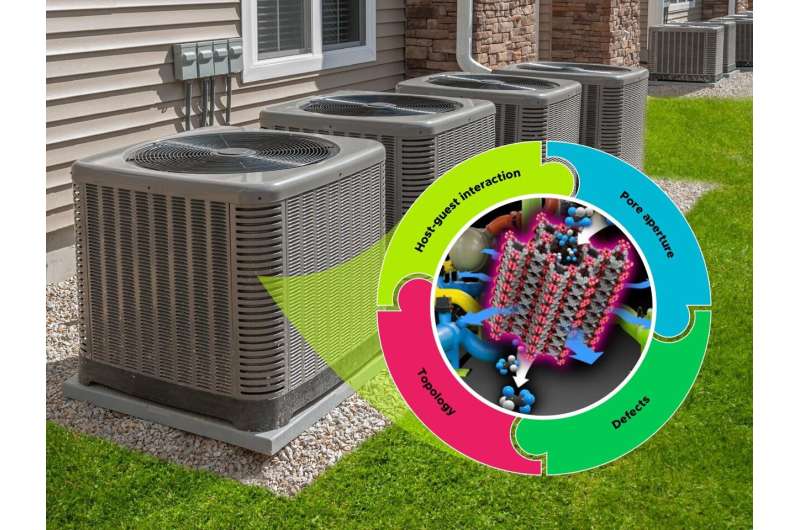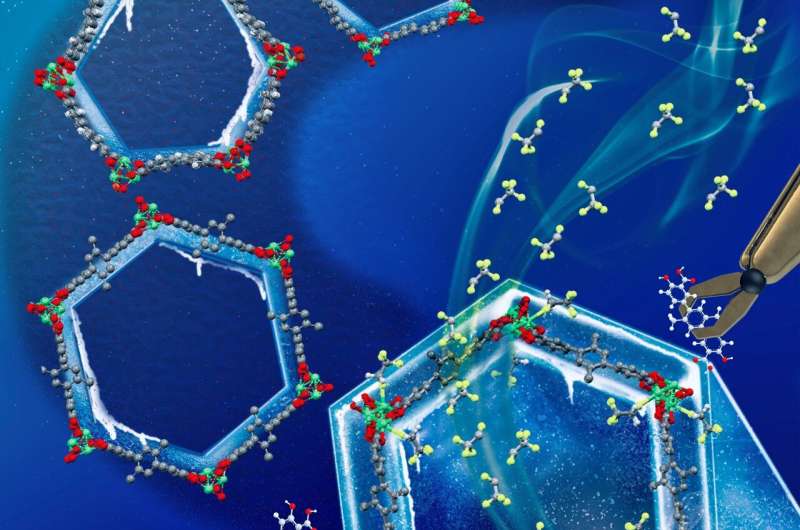
When the heat of summer hits, air conditioners turn on and energy demand skyrockets, straining the grid. In a warmer world, more efficient cooling options will play an important role in curbing the increase of cooling-related energy demands. This will be particularly true for the nearly 80 percent of the global population living in countries surrounding the equator, where even small temperature increases could be life-threatening.
New research from Pacific Northwest National Laboratory (PNNL) provides a roadmap outlining how more efficient cooling systems are feasible with development and support from industry. The invited research study appeared in the journal Accounts of Chemical Research.
“Right now, this is fundamental science. However, this could be a game-changer for industry,” said Radha Motkuri, PNNL chemical engineer and corresponding author.
The chemistry of cool
Motkuri and the research team examined one approach that could offer significant energy savings: adsorption cooling. These systems can run on small amounts of waste heat from a building or industrial plant to power reactions between a vapor refrigerant and a solid material.
“Once we input power the first time, that’s it,” explained Motkuri. “Then, the system keeps on cycling—adsorption, desorption, adsorption, desorption—with very little power input.”
This is in direct contrast to conventional cooling systems that use a compressor and require regular inputs of energy.

Tuning an adsorption cooling system to achieve ideal cooling capacity and energy efficiency requires understanding the complex chemistry between the system’s vapor refrigerant, called the guest, and solid absorbent material, called the host. Motkuri and his collaborators dug into these details—adjusting the pore geometry of the solid sorbent, the speed of chemical interactions, and even the impact of tiny defects in the solid material—to understand how they affect the entire system. Recently, the team was invited to compile their work into an efficient ensemble that can help developers in the cooling industry trying to meet the demand for more energy efficient options.
“Refrigerant-based adsorption cooling eliminates the major cost, efficiency, and reliability issues that have limited adoption of current water-based adsorption cooling systems in commercial and residential buildings,” said Pete McGrail, Laboratory fellow and chemical engineer who led PNNL’s adsorption cooling effort for several years. “This journal article represents a synopsis of years of research into novel sorbent-refrigerant pairs that significantly advanced adsorption cooling technology.”
Environmentally conscious components
With global heatwaves on the rise and cooling-related energy demands expected to triple by 2050, there is a push for cooling systems with smaller environmental footprints. In addition to more energy efficient systems, this includes changing standards for refrigerants.
Commonly used hydrofluorocarbon refrigerants will be phased out in the next few years in favor of more environmentally friendly hydrofluoro-olefins (HFOs). HFOs have a global warming potential near zero, which means that emissions of HFOs hold much less relative heat in the atmosphere compared to emissions of hydrofluorocarbon refrigerants.
Aware of this transition, Motkuri and his collaborators conducted their testing using the readily available, inexpensive hydrofluorocarbon refrigerant R-134a. This hydrofluorocarbon refrigerant has a high global warming potential, but a similar chemical behavior to HFOs, which makes it a suitable alternative for studying the molecular interactions of adsorption cooling systems that will use HFOs in the future. The researchers look forward to integrating HFOs in future adsorption cooling research as the next step in green cooling systems.
PNNL researchers Dushyant Barpaga, Jian Zheng, Peter McGrail, and Radha Motkuri contributed to the article in Accounts of Chemical Research.
Targeting the perfect metal-organic framework cooling combination
Dushyant Barpaga et al, Manipulating Pore Topology and Functionality to Promote Fluorocarbon-Based Adsorption Cooling, Accounts of Chemical Research (2021). DOI: 10.1021/acs.accounts.1c00615
Citation:
Research team introduces roadmap to greener air conditioning for a warmer world (2022, July 27)
retrieved 27 July 2022
from https://techxplore.com/news/2022-07-team-roadmap-greener-air-conditioning.html
This document is subject to copyright. Apart from any fair dealing for the purpose of private study or research, no
part may be reproduced without the written permission. The content is provided for information purposes only.
Stay connected with us on social media platform for instant update click here to join our Twitter, & Facebook
We are now on Telegram. Click here to join our channel (@TechiUpdate) and stay updated with the latest Technology headlines.
For all the latest Technology News Click Here
For the latest news and updates, follow us on Google News.
